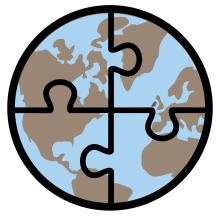As part of a 2017 study, Dr. Camille Stevens-Rumann and her team of scientists sought to determine how a changing climate (drier) over the last several decades impacted post-fire tree regeneration. To answer this question, these scientists measured the regrowth (or lack thereof) of conifer seedlings (young, small trees) from 1485 burn sites across the US Rocky Mountains that were affected by fires during the 1985-2015 time period. The results of this study suggest that seedlings have a hard time regenerating (regrowing) in warm/dry conditions. In a future projected to be warmer and drier, we may see landscapes that were forested before a wildfire, transition to grasslands and shrublands after being burned if conifer seedlings are unable to grow back.
Context for Use
This Data Puzzle is part of a larger collection of Data Puzzle resources that combine classroom-friendly datasets with Ambitious Science Teaching practices to help students make sense of phenomena!

Image of fire and burned landscape
Upcoming Events
Data Puzzle Webinar: Wildfire, Drought, and the Future of Forests
- Professional Learning WorkshopLearn to implement the "Wildfire, Drought, and the Future of Forests" Data Puzzle lesson in this 1-hr virtual webinar hosted by curriculum developer, Jon Griffith. Participants will leave prepared to implement the lesson with their students and subsequently connect their students with fire ecologist Dr. Camille Stevens-Rumann via our September 22nd classroom call!
Read MorePost-Fire Forest Recovery with Dr. Camille Stevens-Rumann
- Science Show and ShareClimate change is not only contributing to the increase in frequency and size of wildfires, but it's also impacting the ability of forests to recover from these wildfires. Join fire ecologist, Dr. Camille Stevens-Rumann, for this 20-minute talk and 25 minute LIVE Q&A classroom call, to learn more about shifting patterns of post-fire landscape recovery. Note that this virtual event is geared towards MS/HS classrooms; however, all are welcome.
Read MoreData Puzzle Webinar: Fast and Destructive Wildfires in the United States
- Professional Learning WorkshopLearn to implement the "Fast and Destructive Fires in the United States" Puzzle Piece resource in this 1-hr virtual webinar hosted by curriculum developer, Jon Griffith. Participants will leave prepared to implement the resource with their students and subsequently connect their students with fire scientist Tyler McIntosh via our October, 22nd classroom call!
Read MoreScience Show & Share Classroom Call with Fire Scientist Tyler McIntosh
- Science Show and ShareClimate change is not only contributing to the increase in frequency and size of wildfires, but it's also impacting the ability of forests to recover from these wildfires. Join fire ecologist, Tyler McIntosh, for this 20-minute talk and 25-minute LIVE Q&A classroom call, to learn more about shifting patterns of post-fire landscape recovery. Note that this virtual event is geared towards MS/HS classrooms; however, all are welcome.
Read More
Goals Header
What Students Will Do
- Analyze and interpret post-fire forest recovery datasets to identify conifer tree regeneration patterns
- Construct a model to explain the relationship between drought (cause) and post-fire tree regeneration (effect) in the northern Rocky Mountains
Teaching Materials
Description
Part 1 – (20 minutes) Eliciting Students’ Ideas
- Access students' prior knowledge post-fire landscape recovery (succession) by asking students to consider what a burned landscape might look like 5, 10, and 20 years after a wildfire.
Part 2 – (40 minutes) Identifying Important Science Ideas
- Students engage with an interactive reading to 1) making connections between the opening scenario prompt and the work of Dr. Camille Stevens-Rumann, a fire ecologist who studies post-fire landscape recovery, and 2) make predictions as it relates to Dr. Stevens-Rumann's research question, "How do climate conditions impact the recovery of forests after a wildfire?"
Part 3 – (40 minutes) Supporting Ongoing Changes in Thinking
- Students test their predictions by analyzing post-fire forest recovery datasets collected from the northern US Rocky Mountains.
Part 4 – (40 minutes) Constructing Evidence-Based Explanations
- Students reflect on evidence gathered during parts 1-3 and construct a final explanatory model for the question, "How do climate conditions impact the recovery of forests after a wildfire?"



